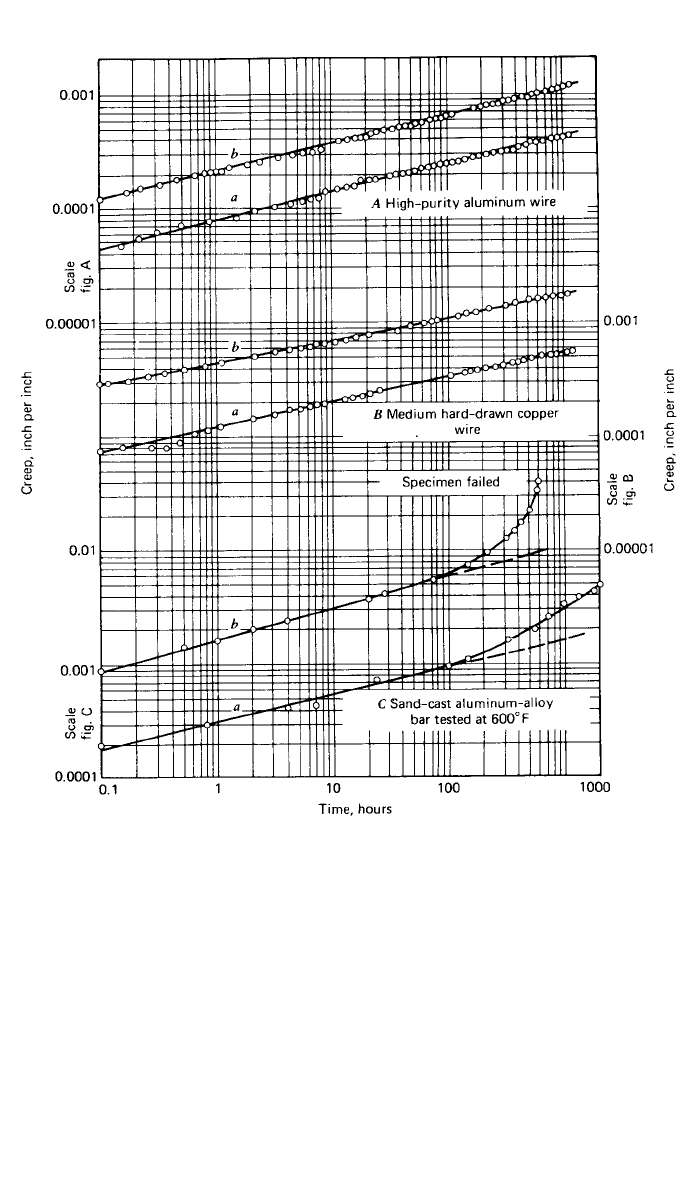Kutz M. Handbook of materials selection
Подождите немного. Документ загружается.


5 FATIGUE 739
the local stress–strain approach
1,33
may be used to compute the number of cycles
N
i
required to initiate a crack, the corresponding length of this initiated crack is
not defined specifically. No consensus has yet been reached regarding the length
of this initiated crack. A size of between 0.25 and 5.0 mm has been suggested,
33
as cracks of this size normally exist at fracture in the small laboratory specimens
used to generate the strain versus cycles to failure data required for the local
stress–strain approach. An alternative approach would involve the assumption
of a preexisting material or manufacturing defect such that N
i
⬇ 0. For example,
such an assumption is often made during the analysis of welded joints.
28
If
nondestructive techniques are employed, a reasonable assumption for the size of
this initial defect would be the largest flaw that could avoid detection.
Crack growth rates determined from constant-amplitude cyclic loading tests
are approximately the same as for random loading tests in which the maximum
stress is held constant but mean and range of stress vary randomly. However, in
random loading tests where the maximum stress is also allowed to vary, the
sequence of loading cycles may have a marked effect on crack growth rate, with
the overall crack growth being significantly higher for random loading spectra.
Many investigations have shown a significant delay in crack propagation fol-
lowing intermittent application of high stresses. That is, fatigue damage and
crack extension are dependent on preceding cyclic load history. This dependence
of crack extension on preceding history and the effects upon future damage
increments are referred to as interaction effects. Most of the interaction studies
conducted have dealt with retardation of crack growth as a result of the appli-
cation of occasional tensile overload cycles. Retardation may be characterized
as a period of reduced crack growth rate following the application of a peak
load or loads higher and in the same direction as those peaks that follow.
The modeling of interaction effects requires consideration of crack-tip plas-
ticity and its subsequent influence. In metals of all types, cracks will remain
closed or partially closed for a portion of the applied cyclic load as a conse-
quence of plastically deformed material left in the wake of the growing crack.
Under cyclic loading, crack growth will occur during the loading portion of the
cycle. Given that a plastic zone exists at the crack tip prior to crack extension,
as the material at the crack tip separates, the newly formed crack surfaces will
exhibit a layer of plastically deformed material along the newly formed crack
faces. Subsequent unloading will compress this plastically deformed material,
closing the crack while the applied stress remains tensile. This phenomenon is
known as plasticity-induced fatigue crack closure and was first discussed by
Elber.
30
Upon reloading during the following cycle, crack growth will not con-
tinue unless the applied load is sufficiently large such that the compressive
stresses acting along the crack surfaces are overcome and the crack is fully
opened. This load is known as the crack opening load and has been demonstrated
to be a key parameter in determining fatigue crack growth rates under both
constant amplitude and spectrum loading. Further information regarding crack
closure may be found in Refs. 1, 4, 16, 26, and 31.
Discussion to this point has been limited to the growth of through-thickness
cracks under mode I loading. While mode I loading is often dominant, under
the most general circumstances the applied cyclic loads will generate stress
intensity factor ranges
⌬K
I
, ⌬K
II
, and ⌬K
III
at the crack tip, and mixed-mode
fatigue crack growth must be considered. Modeling methodologies for mixed-

740 FAILURE MODES
mode fatigue crack growth are discussed in Refs. 34 and 35. In addition, fatigue
cracks in machine elements and structures are often not through-thickness cracks
but rather surface cracks that extend partially through the thickness. Such surface
cracks are often semielliptical in shape and the analysis of these cracks is con-
siderably more complicated. Information regarding surface cracks may be found
in Refs. 4 and 29.
Research has suggested that when fatigue cracks are small, crack growth rates
are larger than would be predicted using Eq. (15) for a given
⌬K.
36
Small-crack
behavior is often important, as a significant portion of the fatigue life may be
spent in the small-crack regime. The fatigue crack propagation life N
p
will also
be influenced by the presence of residual stresses such as might exist as a con-
sequence of welding, heat treatment, carburizing, grinding, or shot-peening.
Compressive residual stresses are beneficial, decreasing the rate of fatigue crack
growth and increasing propagation life. While approximate methodologies exist
for incorporating the effects of residual stress within fatigue crack growth pre-
dictions,
35
residual stress distributions are often difficult to characterize.
Reasonable design estimates for the fatigue crack propagation life may be
obtained using Eq. (17). However, the many uncertainties typically associated
with fatigue life predictions emphasize the essential requirement to conduct full-
scale fatigue tests to provide acceptable reliability.
6 CREEP AND STRESS RUPTURE
Creep in its simplest form is the progressive accumulation of plastic strain in a
specimen or machine part under stress at elevated temperature over a period of
time. Creep failure occurs when the accumulated creep strain results in a defor-
mation of the machine part that exceeds the design limits. Creep rupture is an
extension of the creep process to the limiting condition where the stressed mem-
ber actually separates into two parts. Stress rupture is a term used interchange-
ably by many with creep rupture; however, others reserve the term stress rupture
for the rupture termination of a creep process in which steady-state creep is
never reached, and use the term creep rupture for the rupture termination of a
creep process in which a period of steady-state creep has persisted. Figure 26
illustrates these differences. The interaction of creep and stress rupture with
cyclic stressing and the fatigue process has not yet been clearly understood but
is of great importance in many modern high-performance engineering systems.
Creep strains of engineering significance are not usually encountered until
the operating temperatures reach a range of approximately 35–70% of the melt-
ing point on a scale of absolute temperature. The approximate melting temper-
ature for several substances is shown in Table 2.
Not only is excessive deformation due to creep an important consideration,
but other consequences of the creep process may also be important. These might
include creep rupture, thermal relaxation, dynamic creep under cyclic loads or
cyclic temperatures, creep and rupture under multiaxial states of stress, cumu-
lative creep effects, and effects of combined creep and fatigue.
Creep deformation and rupture are initiated in the grain boundaries and pro-
ceed by sliding and separation. Thus, creep rupture failures are intercrystalline,
in contrast, for example, to the transcrystalline failure surface exhibited by room
temperature fatigue failures. Although creep is a plastic flow phenomenon, the

6 CREEP AND STRESS RUPTURE 741
Fig. 26 Illustration of creep and stress rupture.
Table 2 Melting Temperatures
38
Material ⬚F ⬚C
Hafnium carbide 7030 3887
Graphite (sublimes) 6330 3500
Tungsten 6100 3370
Tungsten carbide 5190 2867
Magnesia 5070 2800
Molybdenum 4740 2620
Boron 4170 2300
Titanium 3260 1795
Platinum 3180 1750
Silica 3140 1728
Chromium 3000 1650
Iron 2800 1540
Stainless steels 2640 1450
Steel 2550 1400
Aluminum alloys 1220 660
Magnesium alloys 1200 650
Lead alloys 605 320

742 FAILURE MODES
intercrystalline failure path gives a rupture surface that has the appearance of
brittle fracture. Creep rupture typically occurs without necking and without
warning. Current state-of-the-art knowledge does not permit a reliable prediction
of creep or stress rupture properties on a theoretical basis. Furthermore, there
seems to be little or no correlation between the creep properties of a material
and its room temperature mechanical properties. Therefore, test data and empir-
ical methods of extending these data are relied on heavily for prediction of creep
behavior under anticipated service conditions.
Metallurgical stability under long-time exposure to elevated temperatures is
mandatory for good creep-resistant alloys. Prolonged time at elevated tempera-
tures acts as a tempering process, and any improvement in properties originally
gained by quenching may be lost. Resistance to oxidation and other corrosive
media are also usually important attributes for a good creep-resistant alloy.
Larger grain size may also be advantageous since this reduces the length of
grain boundary, where much of the creep process resides.
6.1 Prediction of Long-Term Creep Behavior
Much time and effort has been expended in attempting to develop good short-
time creep tests for accurate and reliable prediction of long-term creep and stress
rupture behavior. It appears, however, that really reliable creep data can be ob-
tained only by conducting long-term creep tests that duplicate actual service
loading and temperature conditions as nearly as possible. Unfortunately, design-
ers are unable to wait for years to obtain design data needed in creep failure
analysis. Therefore, certain useful techniques have been developed for approx-
imating long-term creep behavior based on a series of short-term tests. Data
from creep testing may be plotted in a variety of different ways. The basic
variables involved are stress, strain, time, temperature, and, perhaps, strain rate.
Any two of these basic variables may be selected as plotting coordinates, with
the remaining variables treated as parametric constants for a given curve. Three
commonly used methods for extrapolating short-time creep data to long-term
applications are the abridged method, the mechanical acceleration method, and
the thermal acceleration method. In the abridged method of creep testing the
tests are conducted at several different stress levels and at the contemplated
operating temperature. The data are plotted as creep strain versus time for a
family of stress levels, all run at constant temperature. The curves are plotted
out to the laboratory test duration and then extrapolated to the required design
life. In the mechanical acceleration method of creep testing, the stress levels
used in the laboratory tests are significantly higher than the contemplated design
stress levels, so the limiting design strains are reached in a much shorter time
than in actual service. The data taken in the mechanical acceleration method are
plotted as stress level versus time for a family of constant strain curves all run
at a constant temperature. The thermal acceleration method involves laboratory
testing at temperatures much higher than the actual service temperature expected.
The data are plotted as stress versus time for a family of constant temperatures
where the creep strain produced is constant for the whole plot.
It is important to recognize that such extrapolations are not able to predict
the potential of failure by creep rupture prior to reaching the creep design life.

6 CREEP AND STRESS RUPTURE 743
Table 3 Equivalent Conditions Based on
Larson–Miller Parameter
Operating Condition Equivalent Test Condition
10,000 h at 1000⬚F 13 h at 1200⬚F
1,000 h at 1200
⬚F 12 h at 1350⬚F
1,000 h at 1350
⬚F 12 h at 1500⬚F
1,000 h at 300
⬚F 2.2 h at 400⬚F
In any testing method it should be noted that creep testing guidelines usually
dictate that test periods of less than 1% of the expected life are not deemed to
give significant results. Tests extending to at least 10% of the expected life are
preferred where feasible.
Several different theories have been proposed to correlate the results of short-
time elevated-temperature tests with long-term service performance at more
moderate temperatures. One of the more accurate and useful of these proposals
is the Larson–Miller theory.
The Larson–Miller theory
39
postulates that for each combination of material
and stress level there exists a unique value of a parameter P that is related to
temperature and time by the equation
P
⫽ (
⫹ 460)(C ⫹ log t) (19)
10
where P ⫽ Larson–Miller parameter, constant for a given material and stress
level
⫽ temperature, ⬚F
C
⫽ constant, usually assumed to be 20
t
⫽ time in hours to rupture or to reach a specified value of creep strain
This equation was investigated for both creep and rupture for some 28 dif-
ferent materials by Larson and Miller with good success. By using (19) it is a
simple matter to find a short-term combination of temperature and time that is
equivalent to any desired long-term service requirement. For example, for any
given material at a specified stress level the test conditions listed in Table 3
should be equivalent to the operating conditions.
6.2 Creep under a Uniaxial State of Stress
Many relationships have been proposed to relate stress, strain, time, and tem-
perature in the creep process. If one investigates experimental creep strain versus
time data, it will be observed that the data are close to linear for a wide variety
of materials when plotted on log strain versus log time coordinates. Such a plot
is shown, for example, in Fig. 27 for three different materials. An equation
describing this type of behavior is
a
␦
⫽ At (20)

744 FAILURE MODES
Fig. 27 Creep curves for three materials. (From Ref. 40.)
where
␦
⫽ true creep strain
t
⫽ time
A, a
⫽ empirical constants
Differentiating (20) with respect to time gives
⫺
n
˙
␦
⫽ bt (21)
or, setting aA
⫽ b and 1 ⫺ a ⫽ n,
⫺
n
˙
␦
⫽ bt (22)
This equation represents a variety of different types of creep strain versus time

6 CREEP AND STRESS RUPTURE 745
curves, depending on the magnitude of the exponent n.Ifn is zero, the behavior,
characteristic of high temperatures, is termed constant creep rate, and the creep
strain is given as
␦
⫽ bt⫹ C (23)
11
If n lies between 0 and 1, the behavior is termed parabolic creep, and the creep
strain is given by
m
␦
⫽ bt ⫹ C (24)
33
This type of creep behavior occurs at intermediate and high temperatures. The
coefficient b
3
increases exponentially with stress and temperature, and the ex-
ponent m decreases with stress and increases with temperature. The influence of
stress level
on creep rate can often be represented by the empirical expression
N
˙
␦
⫽ b
(25)
Assuming the stress
to be independent of time, we may integrate (25) to
yield the creep strain
N
␦
⫽ Bt
⫹ C⬘ (26)
If the constant C
⬘ is small compared with Bt
N
, as it often is, the result is called
the log-log stress–time creep law, given as
N
⫽ Bt
(27)
As long as the instantaneous deformation on load application and the stage I
transient creep are small compared to stage II steady-state creep, Eq. (27) is
useful as a design tool.
If it is necessary to consider all stages of the creep process, the creep strain
expression becomes much more complex. The most general expression for the
creep process is
41
m
⫺
qt n p
␦
⫽⫹k
⫹ k (1 ⫺ e )
⫹ kt
(28)
12 3
E
where
␦
⫽ total creep strain
/E ⫽ initial elastic strain
k
1
m
⫽ initial plastic strain
k
2
(1 ⫺ e
⫺
qt
)
n
⫽ anelastic strain
k
3
t
p
⫽ viscous strain
⫽ stress
E
⫽ modulus of elasticity
m
⫽ reciprocal of strain-hardening exponent
k
1
⫽ reciprocal of strength coefficient

746 FAILURE MODES
q ⫽ reciprocal of Kelvin retardation time
k
2
⫽ anelastic coefficient
n
⫽ empirical exponent
k
3
⫽ viscous coefficient
p
⫽ empirical exponent
t
⫽ time
To utilize this empirical nonlinear expression in a design environment requires
specific knowledge of the constants and exponents that characterize the material
and temperature of the application. In all cases it must be recognized that stress
rupture may intervene to terminate the creep process, and the prediction of this
occurrence is difficult.
7 FRETTING AND WEAR
Fretting and wear share many common characteristics but, at the same time, are
distinctly different in several ways. Basically, fretting action has, for many years,
been defined as a combined mechanical and chemical action in which contacting
surfaces of two solid bodies are pressed together by a normal force and are
caused to execute oscillatory sliding relative motion, wherein the magnitude of
normal force is great enough and the amplitude of the oscillatory sliding motion
is small enough to significantly restrict the flow of fretting debris away from the
originating site.
42
More recent definitions of fretting action have been broadened
to include cases in which contacting surfaces periodically separate and then
reengage, as well as cases in which the fluctuating friction-induced surface trac-
tions produce stress fields that may ultimately result in failure. The complexities
of fretting action have been discussed by numerous investigators, who have
postulated the combination of many mechanical, chemical, thermal, and other
phenomena that interact to produce fretting. Among the postulated phenomena
are plastic deformation caused by surface asperities plowing through each other,
welding and tearing of contacting asperities, shear and rupture of asperities,
friction-generated subsurface shearing stresses, dislodging of particles and
corrosion products at the surfaces, chemical reactions, debris accumulation
and entrapment, abrasive action, microcrack initiation, and surface delamina-
tion.
43–58
Damage to machine parts due to fretting action may be manifested as cor-
rosive surface damage due to fretting corrosion, loss of proper fit or change in
dimensions due to fretting wear, or accelerated fatigue failure due to fretting
fatigue. Typical sites of fretting damage include interference fits; bolted, keyed,
splined, and riveted joints; points of contact between wires in wire ropes and
flexible shafts; friction clamps; small-amplitude-of-oscillation bearings of all
kinds; contacting surfaces between the leaves of leaf springs; and all other places
where the conditions of fretting persist. Thus, the efficiency and reliability of
the design and operation of a wide range of mechanical systems are related to
the fretting phenomenon.
Wear may be defined as the undesired cumulative change in dimensions
caused by the gradual removal of discrete particles from contacting surfaces in
motion, due predominantly to mechanical action. It should be further recognized
that corrosion often interacts with the wear process to change the character of

7 FRETTING AND WEAR 747
the surfaces of wear particles through reaction with the environment. Wear is,
in fact, not a single process but a number of different processes that may take
place by themselves or in combination. It is generally accepted that there are at
least five major subcategories of wear (see p. 120 of Ref. 59, see also Ref. 60),
including adhesive wear, abrasive wear, corrosive wear, surface fatigue wear,
and deformation wear. In addition, the categories of fretting wear and impact
wear
55,61,62
have been recognized by wear specialists. Erosion and cavitation are
sometimes considered to be categories of wear as well. Each of these types of
wear proceeds by a distinctly different physical process and must be separately
considered, although the various subcategories may combine their influence ei-
ther by shifting from one mode to another during different eras in the operational
lifetime of a machine or by simultaneous activity of two or more different wear
modes.
7.1 Fretting Phenomena
Although fretting fatigue, fretting wear, and fretting corrosion phenomena are
potential failure modes in a wide variety of mechanical systems, and much
research effort has been devoted to the understanding of the fretting process,
there are very few quantitative design data available, and no generally applicable
design procedure has been established for predicting failure under fretting con-
ditions. However, even though the fretting phenomenon is not fully understood,
and a good general model for prediction of fretting fatigue or fretting wear has
not yet been developed, significant progress has been made in establishing an
understanding of fretting and the variables of importance in the fretting process.
It has been suggested that there may be more than 50 variables that play some
role in the fretting process.
63
Of these, however, there are probably only 8 that
are of major importance:
1. The magnitude of relative motion between the fretting surfaces
2. The magnitude and distribution of pressure between the surfaces at the
fretting interface
3. The state of stress, including magnitude, direction, and variation with
respect to time in the region of the fretting surfaces
4. The number of fretting cycles accumulated
5. he material, and surface condition, from which each of the fretting mem-
bers is fabricated
6. Cyclic frequency of relative motion between the two members being fret-
ted
7. Temperature in the region of the two surfaces being fretted
8. Atmospheric environment surrounding the surfaces being fretted
These variables interact so that a quantitative prediction of the influence of
any given variable is very dependent on all the other variables in any specific
application or test. Also, the combination of variables that produce a very serious
consequence in terms of fretting fatigue damage may be quite different from the
combinations of variables that produce serious fretting wear damage. No general
techniques yet exist for quantitatively predicting the influence of the important

748 FAILURE MODES
variables of fretting fatigue and fretting wear damage, although many special
cases have been investigated. However, it has been observed that certain trends
usually exist when the variables just listed are changed. For example, fretting
damage tends to increase with increasing contact pressure until a nominal pres-
sure of a few thousand pounds per square inch is reached, and further increases
in pressure seem to have relatively little direct effect. The state of stress is
important, especially in fretting fatigue. Fretting damage accumulates with in-
creasing numbers of cycles at widely different rates, depending on specific op-
erating conditions. Fretting damage is strongly influenced by the material
properties of the fretting pair-surface hardness, roughness, and finish. No clear
trends have been established regarding frequency effects on fretting damage, and
although both temperature and atmospheric environment are important influenc-
ing factors, their influences have not been clearly established. A clear presen-
tation relative to these various parameters is given in Ref. 55.
Fretting fatigue is fatigue damage directly attributable to fretting action. It
has been suggested that premature fatigue nuclei may be generated by fretting
through either abrasive pit-digging action, asperity-contact microcrack initia-
tion,
64
friction-generated cyclic stresses that lead to the formation of micro-
cracks,
65
or subsurface cyclic shear stresses that lead to surface delamination in
the fretting zone.
58
Under the abrasive pit-digging hypothesis, it is conjectured
that tiny grooves or elongated pits are produced at the fretting interface by the
asperities and abrasive debris particles moving under the influence of oscillatory
relative motion. A pattern of tiny grooves would be produced in the fretted
region with their longitudinal axes all approximately parallel and in the direction
of fretting motion, as shown schematically in Fig. 28.
The asperity-contact microcrack initiation mechanism is postulated to proceed
due to the contact force between the tip of an asperity on one surface and another
asperity on the mating surface as the surfaces move back and forth. If the initial
contact does not shear one or the other asperity from its base, the repeated
contacts at the tips of the asperities give rise to cyclic or fatigue stresses in the
region at the base of each asperity. It has been estimated
51
that under such
conditions the region at the base of each asperity is subjected to large local
stresses that probably lead to the nucleation of fatigue microcracks at these sites.
As shown schematically in Fig. 29, it would be expected that the asperity-contact
mechanism would produce an array of microcracks whose longitudinal axes
would be generally perpendicular to the direction of fretting motion.
The friction-generated cyclic stress fretting hypothesis
53
is based on the ob-
servation that when one member is pressed against the other and caused to
undergo fretting motion, the tractive friction force induces a compressive tan-
gential stress component in a volume of material that lies ahead of the fretting
motion, and a tensile tangential stress component in a volume of material that
lies behind the fretting motion, as shown in Fig. 30a. When the fretting direction
is reversed, the tensile and compressive regions change places. Thus, the volume
of material adjacent to the contact zone is subjected to a cyclic stress that is
postulated to generate a field of microcracks at these sites. Furthermore, the
geometrical stress concentration associated with the clamped joint may contrib-
ute to microcrack generation at these sites.
54
As shown in Fig. 30c, it would be
expected that the friction-generated microcrack mechanism would produce an
